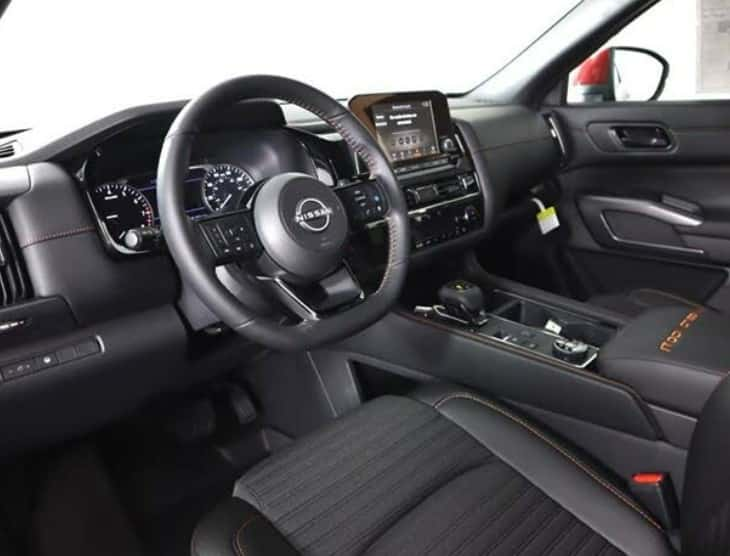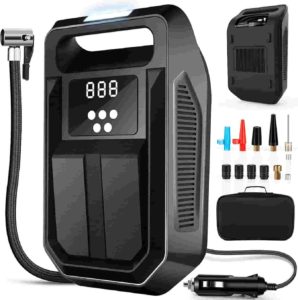What is the TPMS in a Nissan Pathfinder?
Navigating your Nissan Pathfinder’s tire pressure monitoring system (TPMS) might feel like a puzzle. With the assortment of lights on your dashboard, understanding what each one means and how to respond can be a challenge. That’s where this comprehensive guide comes in! From resetting your tire pressure light to understanding how weather affects your tire pressure, we’ve got you covered! Dive into the world of TPMS, demystify those blinking lights and ensure a safer, smoother ride. Buckle up and let’s explore the ins and outs of maintaining optimal tire pressure in your Nissan Pathfinder.
How to Reset 2023 Nissan Pathfinder Tire Pressure Light
The Nissan Pathfinder does not have a tire pressure reset button. It has what is called “Easy-Fill Tire Alert” which provides you with audible and visual signals while inflating your tires.
Park your Pathfinder in a safe and level place.
Apply the parking brake and put the SUV in Park.
Put the ignition to the ON position. This means engine off, electricity on.
Check and adjust your tire pressures. As you start adding air, the hazard indicators will start flashing.
Once the correct amount of air has been reached, the horn of your Pathfinder will beep once and the hazard indicators will stop flashing.
Repeat the same steps for every tire. (if the tire is overinflated by more than 4 Psi, the horn will beep and the hazard indicators will flash 3 times.)
After adjusting the tire pressure, drive the vehicle at speeds above 16 MPH (25 km/h). The low tire pressure warning light does not automatically turn off when the tire pressure is adjusted. After the vehicle speed reaches 16 MPH (25 km/h), the light will turn off.
If the low tire pressure warning light flashes for approximately 1 minute and then remains on after you turn the ignition switch to the ON position, the TPMS is not functioning properly. (read more about TPMS malfunction below)
If the light doesn’t go off right away, re-check your tire pressure to make sure they are all at the exact pressure you set them to. If the pressure has decreased, you probably have some sort of leak in that tire.
If your tires are not losing air and the tire light still won’t go out, try overfilling your tires by about 10 Psi. So, fill them to 43 Psi and then drive the car for a few minutes. The tire light should reset. Remember: DO NOT leave the tires at this level, release the extra 10 Psi afterwards.
NOTE: The tire pressure monitoring system (TPMS) will not turn off the low tire pressure warning light until the tire pressure is set to the recommended pressure and the vehicle is driven at speeds above 16 MPH (25 km/h). If you’ve completed these steps and the tire light STILL won’t go out, There is only one of three things that can be the problem. Either have a faulty tire pressure sensor in one of your wheels OR you have a leak OR your receiver module (control unit) is not communicating with your sensors (this is the least of all likely and is rare).
2023 Nissan Pathfinder Tire Pressures & Sizes
TIRE SIZE | FRONT PSI | REAR PSI |
255/50R20 | 35 | 35 |
255/60R18 | 33 | 33 |
265/60R18 | 36 | 36 |
SPARE TIRE | 60 | 60 |
Tire Settings
Steps to Turn Off the Tire Maintenance Light
Move the shift lever to the P (Park) position, then turn the ignition switch to the ON position.
Use the steering wheel switches to select the “Settings” menu on the vehicle information display.
Select “Vehicle Settings“, then “Tire“, and finally “Tire Maintenance”.
Select “Reset“, then select “Yes“.
Press the back button to return to the previous screen.
How to Change Tire Pressure Units
Press the “MENU” button on the control panel.
Use the touch-screen to select “Settings“.
In the “Settings” menu, select “Meter Settings“.
In the “Meter Settings” menu, select “Tire Pressure Unit“.
Choose between “PSI“, “kPa“, or “bar” as your preferred unit for tire pressure measurement.
How Does the Nissan Pathfinder TPMS Work?
The Nissan Pathfinder’s Tire Pressure Monitoring System (TPMS) is an essential safety feature that helps you keep track of your car’s tire pressure. It’s quite a complex system, but let’s break it down into several components: the tire pressure sensors, the data transmission process, the receiver module, and the Electronic Control Unit (ECU)
Tire Pressure Sensors
Each tire on the Nissan Pathfinder is equipped with a TPMS sensor. This sensor is a small electronic device mounted on the wheel inside the tire’s air chamber. In the Nissan Pathfinder, the TPMS sensor is part of the valve stem.
The sensor is powered by a small battery and constantly measures the air pressure inside the tire. It operates based on a microcontroller and a pressure sensing component. The pressure sensing element is typically a piezoresistive strain gauge. As the tire pressure changes, it causes a strain in the sensor, and this strain is converted into an electrical signal that can be interpreted by the sensor’s microcontroller.
Data Transmission
Once the tire pressure sensor measures the tire pressure, it doesn’t just keep the information to itself. Instead, it transmits the data to a receiver module, often called the TPMS module, via radio frequency signals. The sensor employs a small RF (Radio Frequency) transmitter to send this signal.
Each sensor has a unique ID code, which is transmitted along with the tire pressure data. This allows the TPMS module to know which sensor (and therefore which tire) the data is coming from. The TPMS sensors are set to transmit data at regular intervals, but they can also be prompted to transmit data via a signal from the TPMS module.
Receiver Module
The receiver module, also known as the TPMS module or TPMS receiver, is responsible for receiving the signals transmitted by the TPMS sensors. It’s equipped with an RF receiver that can pick up the signals from the sensors. It interprets the data received, identifying the unique ID from each sensor and the corresponding tire pressure.
Electronic Control Unit (ECU)
The final part of the system is the Electronic Control Unit or the main car computer. This ECU communicates with the TPMS module and several other systems in your car. After the TPMS module processes the tire pressure data, it sends it to the ECU.
The ECU uses this data in a couple of ways. First, it can display the tire pressures on the driver information display so that you can monitor them. Secondly, it can trigger a warning light on your dashboard (the yellow exclamation mark inside a tire symbol) if the tire pressure in one or more of your tires is too low.
If the system identifies a significant tire under-inflated, it will illuminate the TPMS warning light. If it detects rapid deflation, it may sound a warning chime. The system is also able to detect a malfunction in the TPMS system itself, such as a sensor battery running low, and can indicate this with a separate TPMS malfunction indicator. (read more about this below)
The TPMS doesn’t just monitor the tire pressure either. With the data from all four sensors, it can also monitor the relative tire pressures. If one tire’s pressure is significantly different from the others (even if it’s within the acceptable range), the system may also trigger a warning.
What is the TPMS Malfunction Indicator?
The Nissan Pathfinder’s tire pressure monitoring system also has a malfunction indicator to alert you when something is wrong with the system itself. The indicator uses the same yellow exclamation point as the low tire pressure light. The difference is that, if there is a problem with the system, the light will flash for approximately 60 seconds before staying on. This flashing or blinking will happen every time you start your Pathfinder until the issue is resolved. When your tire light is flashing your Pathfinder will not be able to give you accurate pressure readings. Basically, a blinking tire pressure light means there is a malfunction within the TPMS itself, rather than an air pressure issue. This is usually due to a faulty pressure sensor in one of your tires (a dead battery) or driving with the spare tire. (if the spare doesn’t have a sensor in it) To figure out which sensor is malfunctioning or faulty, use a TPMS diagnostic tool and scan each sensor for diagnostic information or bring your car to a professional.
What Will Cause a TPMS Malfunction
Using non Nissan wheels or tires.
Devices operating on the same radio frequencies can cause disruptions to the tire pressure monitoring system (TPMS), leading to operational issues. These disruptions can originate from various sources, even something as common as a radio or the security alarm of a nearby store.
If your Pathfinder’s windows are highly tinted, it might interfere with the radio signals transmitted between the TPMS sensors and the receiver.
If there’s significant snow or ice build-up on or around the tire valves
If the tire pressure is extremely high.
If wheels without tire pressure sensors are installed on the car. This includes the spare tire if your spare does not have a sensor in it.
If new tire pressure sensors are installed without registering the new sensor IDs with the Pathfinder’s receiver module/ECU.
What Causes the Tire Pressure Light to Turn On?
Seasonal temperature changes: A drop in ambient temperature can cause tire pressure to decrease, triggering the warning light.
Tire puncture or leak: A sharp object or road debris like a nail or screw may puncture a tire, causing air loss which will of course activate the warning light.
Faulty tire pressure sensor: Damaged or malfunctioning sensors may provide inaccurate readings, resulting in a false alert. The only way to determine which sensor is faulty is to scan each sensor with a TPMS diagnostic tool.
Valve stem issues: A damaged or leaking valve stem can lead to gradual pressure loss and eventual activation of the tire pressure light. They make kits to replace the rubber gasket that usually goes bad.
Tire damage: Impact from potholes or hitting a curb can cause structural damage like tire bubbles, leading to pressure loss.
Sensor battery life: TPMS sensors are battery-powered, and over time, batteries die. (they usually last anywhere from 5-10 years) This will cause the tire pressure light to turn on. Again, you must use a diagnostic tool to determine which sensor is dead or dying.
Recent tire rotation or replacement: If the tires have been recently rotated or replaced, the TPMS may need recalibration to avoid false alerts. Sometimes the vehicle’s computer may think the front tires are in the rear and rear in the front after a rotation.
Wheel or rim issues: Damaged, corroded, or cracked wheels or rims can lead to air leaks and pressure loss. This is very common with low profile tires.
Altitude changes: Climbing or descending in elevation can affect tire pressure and trigger the TPMS warning. An additional 1.5 Psi per Km above sea level is required.
Natural pressure loss: Tires lose air pressure over time due to temperature changes and permeation. Tire dry-rot will happen to tires that sit.
Electrical problems or software issues within the car’s TPMS system. Occasionally the system may have a software update from Nissan.
Snow Tires: If you have a separate pair of wheels/rims for your snow tires, you can either transfer the sensors from your summer wheels or acquire an additional set of 4 sensors for the second pair of wheels/rims. However, if you are using the same wheels for both sets of tires, there is no need to be concerned about this.
What Happens When Tires are Underinflated or Overinflated?
When tires are underinflated or overinflated in your Nissan Pathfinder, several issues can arise:
Effects of Underinflation:
Reduced Fuel Efficiency: Underinflated tires have higher rolling resistance, which means the engine has to work harder to move the car, resulting in lower fuel efficiency.
Poor Handling: Underinflated tires can negatively affect the vehicle’s handling and responsiveness, making it less stable when turning or steering.
Increased Tire Wear: Underinflated tires can cause the tires to wear unevenly and prematurely. They tend to wear more on the edges because they collapse and cause more of the tire’s outer areas to contact the road.
Risk of Tire Damage: Underinflated tires are more susceptible to damage like punctures and can also suffer from internal damage due to the excess heat generated from over-flexing.
Overheating: Underinflated tires will overheat, which can lead to tire failure, including the risk of a blowout.
Effects of Overinflation:
Reduced Traction: Overinflated tires tend to bulge in the middle, reducing the tire’s contact with the road and therefore reducing traction.
Harsher Ride: Overinflated tires are hard and will result in a harsher ride as they are less able to absorb the impact from bumps and potholes.
Increased Wear in the Center: Overinflated tires can cause more wear in the center of the tire because they bulge out and cause more of the tire’s middle area to contact the road.
Risk of Damage: Overinflated tires are more susceptible to damage like punctures or impact damage (from hitting a pothole, for example), because they don’t flex and are less able to absorb shocks.
Risk of Blowouts: Overinflated tires can also be at a higher risk of a blowout, especially when driving at high speeds or in hot weather, due to increased tension in the tire side-walls.
By maintaining your tires at the recommended pressure, you can avoid these potential issues and ensure your Nissan Pathfinder drives as efficiently, safely, and smoothly as possible.
Does the Weather Affect Tire Pressure?
Changes in weather can significantly impact your Nissan Pathfinder’s tire pressure, largely due to the principle that gasses expand when heated and contract when cooled. During warmer conditions the air inside your tires will expand, causing overinflation. On the other hand, as temperatures drop in colder weather the air contracts, leading to underinflation. It’s not uncommon to see your car’s tire pressure warning light illuminate on a particularly cold morning, even if your tires were at the correct pressure the previous day. Such fluctuations are normal but underscore the importance of regularly checking your tire pressure, especially when weather conditions change. A general rule of thumb states that for every 10-degree Fahrenheit change in temperature, tire pressure will decrease or increase by approximately 1 psi in the same direction.
How to Adjust Tire Pressure:
Make sure the tires are cold. If your vehicle has been driven, wait at least three hours before checking the tire pressure.
Remove the valve cap from the tire.
Press the tip of the tire pressure gauge onto the valve and read the pressure.
If the tire pressure is below the recommended level, fill the tire with air until the recommended pressure is reached. If the tire pressure is above the recommended level, release air until it reaches the recommended pressure. (Press the metal stem in the center of the tire valve. You can use any object like a screwdriver to do this. Be gentle.)
After adjusting the tire pressure, don’t forget to put the valve caps back on to prevent leaks and keep dirt and moisture out.
Repeat this process for each tire, including the spare if applicable.
When Should You Adjust Your Tire Pressure?
To get an accurate tire pressure reading on your Nissan Pathfinder, check it when your car has been sitting for a while, preferably in the morning. This is known as checking the “cold pressure” after the vehicle has been stationary for about three hours or more. When you drive, your tires warm up, causing the air inside to expand. This will result in inaccurate high pressure readings. So, don’t adjust the tire pressure right after driving, you’ll end up with overinflated tires!
Conclusion
Keeping the tire pressure of your Nissan Pathfinder at the recommended level is not just about extinguishing that annoying warning light—it’s about safety, fuel efficiency, and longevity of your tires. Navigating the TPMS might seem complex, but with the right understanding and a few simple steps, you can master it like a pro. So, remember to regularly check and adjust your tire pressures, and don’t ignore any alerts. After all, the path to successful driving adventures starts with well-inflated tires! Everything in this article is applicable to all Nissan Pathfinder models and trims. Including Pathfinder FWD & AWD, Pathfinder S, Pathfinder SV, Pathfinder SL, and Pathfinder Rock Creek, and Pathfinder Platinum.
Please note that this blog post contains Amazon affiliate links. This means that if you make a purchase through one of these links, we at TPMSRESET.com may earn a small commission at no extra cost to you. We only recommend products that we personally use and believe in. Thank you for supporting us.





